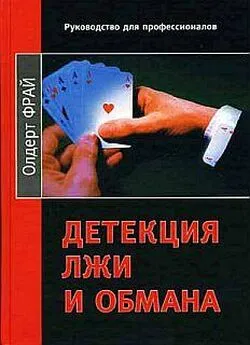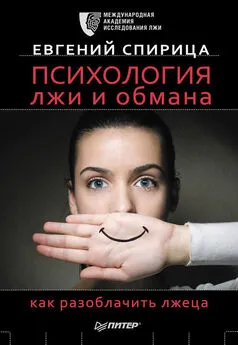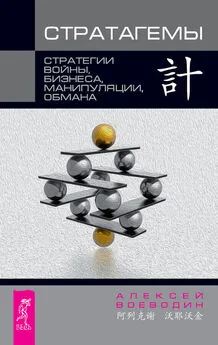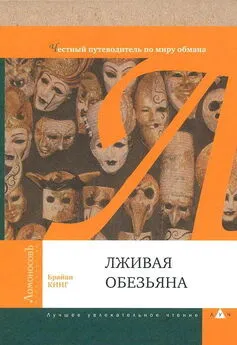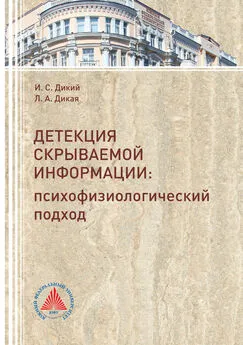Олдерт Фрай - Детекция лжи и обмана
- Название:Детекция лжи и обмана
- Автор:
- Жанр:
- Издательство:Издательский дом Нева ПРАЙМ-ЕРОЗНАК - Санкт-Петербург; ОЛМА-ПРЕСС - Москва
- Год:2005
- ISBN:5-93878-157-4
- Рейтинг:
- Избранное:Добавить в избранное
-
Отзывы:
-
Ваша оценка:
Олдерт Фрай - Детекция лжи и обмана краткое содержание
Как распознать ложь и обман в поведении и речи человека? Эти фундаментальные вопросы находят свое решение на страницах предлагаемого руководства. Без сомнения, эта книга — самый важный за последние годы вклад в теорию и практику психологии лжи и обмана. Впервые так полно и ясно представлены исследования психологических и физиологических показателей правдивого и лживого поведения и речи, а также — фактология использования метода детекции лжи и обмана с помощью полиграфа.
Эта книга принесет пользу всем, кто должен знать, говорят ли окружающие правду, и иметь практическое руководство, чтобы обеспечить себе это знание — для социальных и юридических психологов, криминалистов, политических консультантов и адвокатов.
Детекция лжи и обмана - читать онлайн бесплатно полную версию (весь текст целиком)
Интервал:
Закладка:
Bull, R. (1989). Can training enhance the detection of deception? In J. С Yuille (Ed.), Credibility assessment. Dordrecht: Kluwer, 83–91.
Bull, R. (1992). Obtaining evidence expertly: the reliability of interviews with child witnesses. Expert Evidence: The International Digest of Human Behaviour Science and Law, 1, 3-36.
Bull, R. (1995). Innovative techniques for the questioning of child witnesses, especially those who are young and those with learning disability. In M. Zaragoza et al. (Eds), Memory and testimony in the child witness. Thousand Oaks, CA: Sage, 119–195.
Bull, R. (1998). Obtaining information from child witnesses. In A. Memon, A. Vrij & R. Bull, Psychology and law: truthfulness, accuracy and credibility. Maidenhead: McGraw-Hill, 188–210.
Buller, D.B. & Aune, R.K. (1981). Nonverbal cues to deception among intimates, friends, and strangers. Journal of Nonverbal Behavior, 11, 269–289.
Buller, D.B., Burgoon, J.K., Busling, A.L. & Roiger, J.F. (1994a). Interpersonal deception. VIII. Further analysis of nonverbal and verbal correlates of equivocation from the Bauelas et al. (1990) research. Journal of Language and Social Psychology, 13, 396–411.
Buller, D.B., Burgoon, J.K., White, C.H. & Ebesu, A.S. (1994b). Interpersonal deception. VII. Behavioral profiles of falsification, equivocation and concealment. Journal of Language and Social Psychology, 13, 366–395.
Buller, D.B., Comstock, J„Aune, R.K. & Strzyzewski, K.D. (1989). The effect of probing on deceivers and truthtellers. Journal of Nonverbal Behavior, 13, 155110.
Buller, D.B., Stiff, J.B. & Burgoon, J.K. (1996). Behavioral adaptation in deceptive transactions. Fact or fiction: a reply to Levine and McCornack. Human Communication Research, 22, 589–603.
Buller, D.B., Strzyzewski, K.D. & Comstock, J. (1991a). Interpersonal deception.
I. Deceivers' reactions to receivers' suspicions and probing. Communication Monographs, 58, 1-24. Buller, D.B., Strzyzewski, K.D. & Hunsaker, EG. (1991b). Interpersonal deception.
II. The inferiority of conversational participants as deception detectors. Communication Monographs, 58, 25–40.
deTurck, M.A. & Miller, G.R. (1985). Deception and arousal: isolating the behavioral correlates of deception. Human Communication Research, 12, 181–201.
deTurck, M.A. & Miller, G.R. (1990). Training observers to detect deception: effects of self-monitoring and rehearsal. Human Communication Research, 16, 603–620.
deTurck, M.A., Feeley, Т.Н. & Roman, L.A. (1991). Vocal and visual cue training in behavioural lie detection. Communication Research Reports, 14, 249–259.
deTurck, M.A., Harszlak, J.J., Bodhorn, DJ. & Texter, L.A. (1990). The effects of training social perceivers to detect deception from behavioural cues. Communication Quarterly, 38,189–199.
Dulaney, E.F. (1982). Changes in language behavior as a function of veracity. Human Communication Research, 9, 15–82.
Ebesu, A.S. & Miller, M.D. (1994). Verbal and nonverbal behaviors as a function of deception type. Journal of Language and Social Psychology, 13, 418–442.
Edinger, J.A. & Patterson, M.L. (1983). Nonverbal involvement and social control. Psychological Bulletin, 93, 30–56.
Ekman, P. (1981). Mistakes when deceiving. Annals of the Nebs York Academy of Sciences, 364, 269–218.
Ekman, P. (1988). Lying and nonverbal behavior: theoretical issues and new findings. Journal of Nonverbal Behavior, 12,163–116.
Ekman, P. (1989). Why lies fail and what behaviors betray a lie. In J. С Yuille (Ed.), Credibility assessment. Dordrecht: Kluwer, 11–82.
Ekman, P. (1992). Telling lies: clues to deceit in the marketplace, politics and marriage. New York: W. W Norton.
Ekman, P. (1993). Why don't we catch liars? Social Research, 63,801–811.
Ekman, P. (1991). Deception, lying, and demeanor. In D. F. Halpern & A. E. Vois-kounsky (Eds), States of mind: American and post-soviet perspectives on contemporary issues in psychology. New York: Oxford University Press, 93-105.
Ekman, P. & Frank, M. G. (1993). Lies that fail. In M. Lewis & С Saarni (Eds), Lying and deception in everyday life. New York: Guilford Press, 184–201.
Ekman, P. & Friesen, W. V. (1969). Nonverbal leakage and clues to deception. Psychiatry, 32,88-106.
Ekman, P. & Friesen, W. V. (1912). Hand movements.yoMraa/ of Communication, 22, 353–314.
Ekman, P. & Friesen, W. V. (1914). Detecting deception from the body or face.Journal of Personality and Social Psychology, 29, 288–298.
Ekman, P. & Friesen, W. V. (1982). Felt, false and miserable smiles. Journal of Nonverbal Behavior, 6, 238–253.
Ekman, P. & O'Sullivan, M. (1991). Who can catch a liar? American Psychologist, 46, 913–920.
Ekman, P., Davidson, R.J. & Friesen, W. V. (1990). The Duchenne smile: emotional expression and brain physiology. II. Journal of Personality and Social Psychology, 58,342–353.
Ekman, P., Friesen, W.V. & O'Sullivan, M. (1988). Smiles when lying. Journal of Personality and Social Psychology, 54, 414–420.
Ekman, P., Friesen, W.V., & Scherer, K.R. (1916). Body movement and voice pitch in deceptive interaction. Semiotica, 16, 23–21.
Ekman, P., O'Sullivan, M., Friesen, W. V. & Scherer, K. (1991). Face, voice, and body in detecting deceit. Journal of Nonverbal Behavior, 15, 125–135.
Elaad, E. (1990). Detection of guilty knowledge in real-life criminal investigations. Journal of Applied Psychology, 15, 521–529.
Elaad, E. (1993). Detection of deception: a transactional analysis perspective./owma/ of Psychology, 121,5-15.
Elaad, E. (1991). Polygraph examiner awareness of crime-relevant information and the guiltyknowledge test. Law and Human Behavior, 21, 101–120.
Elaad, E. & Ben-Shakhar, B. (1991). Effects of item repetitions and variations on the efficiency of the guilty knowledge test. Psychophysiology, 34, 581–596.
Elaad, E., Ginton, A. & Jungman, N. (1992). Detection measures in real-life criminal guilty knowledge tests. Journal of Applied Psychology, 11, 151–161.
Elaad, E., Ginton, A. & Shakhar, G. (1994). The effects of prior expectations and outcome knowledge on polygraph examiners' decisions. Journal of Behavioral Decision-Making, 7, 219–292.
Esplin, PW, Boychuk, T & Raskin, D.C. (1988). Afield validity study of Criteria-Based Content Analysis of children's statements in sexual abuse cases. Paper presented at the NATO Advanced Study Institute on Credibility Assessment in Maratea, Italy, June 1988.
Exline, R., Thibaut,J., Rickey, C. & Gumpert, P. (1910). Visual interaction in relation to machiavellianism and an unethical act. In P. Christie & F. Geis (Eds), Studies in machiavellianism. New York: Academic Press, 53–15.
Eysenck, H.J. (1984). Crime and personality. In D.J. Muller, D. E. Blackman & A. J. Chapman (Eds), Psychology and law. New York: John Wiley, 85-100.
Faigman, D. L., Kaye, D., Saks, M. J. & Sanders, J. (1991) . Modem scientific evidence: the law and science of expert testimony. St Paul, MN: West.
Farwell, L. A. & Donchin, E. (1991). The truth will come out: interrogative polygraphy ("lie detection") with event-related brain potentials. Psychophysiology, 28,531–541.
Feeley, Т. H. & deTurck, M. A. (1991). Perceptions of communication as seen by the actor and as seen by the observer: the case of lie detection. Paper presented at the International Communication Association Annual Conference, Montreal, Canada, 1991.
Feeley, Т. H. & deTurck, M. A. (1998). The behavioral correlates of sanctioned and unsanctioned deceptive communication. Journal of Nonverbal Behavior, 22,189–204.
Feeley, T. H. & Young, M.J. (1991) . Detecting deceptive communication: a narrative review. Unpublished manuscript.
Feeley, T. H., deTurck, M. A. & Young, M.J. (1995). Baseline familiarity in lie detection. Communication Research Reports, 12,160–169.
Feldman, R. S., Jenkins, L. & Popoola, O. (1919). Detection of deception in adults and children via facial expressions. Child Development, 50, 350–355.
Fiedler, K. & Walka, I. (1993). Training lie detectors to use nonverbal cues instead of global heuristics. Human Communication Research, 20,199–223.
Fisher, R. P. & Geiselman, R. E. (1992). Memory-enhancing techniques for investigative interviewing: the cognitive interview. Springfield, IL: Charles C. Thomas.
Flavell, J. FL, Botkin, P. T, Fry, С. K., Wright,J. С &Jarvis, P. T. (1968). The development of role-taking and communication skills in children. New York: John Wiley.
Foley, M.A. & Johnson, M.K. (1985). Confusions between memories for performed and imagined actions: a developmental comparison. Child Development, 56,1145–1155.
Ford, Ch. V. (1995). Lies! Lies!! Lies.!! The psychology of deceit. Washington, DC: American Psychiatric Press.
Frank, M.G. & Ekman, P. (1991). The ability to detect deceit generalizes across different types of high-stake lies. Journal of Personality and Social Psychology, 12, 1429–1439.
Freedman, J. L. Adam, E. K., Davey, S. A. & Koegl, C.J. (1996). The impact of a statement: more detail does not always help. Legal and Criminological Psychology, 1, 111–130.
Freud, S. (1959). Collected papers. New York: Basic Books.
Fugita, S. S., Wexley, K. N. & Hillery, J. M. (1914). Black-white differences in nonverbal behavior in an interview setting. Journal of Applied Social Psychology, 4,343–351.
Furedy, J.J. (1991a). Alice in Wonderland terminological usage in, and communicational concerns about, that peculiar flight of technological fancy: the CQT polygraph. Integrative Physiological and Behavioral Science, 26, 241–241.
Furedy, J.J. (1991b). On the validity of the polygraph. Integrative Physiological and Behavioral Science, 26, 211–213.
Furedy, J. J. (1993). The «control» question «test» (CQT) polygrapher's dilemma: logico-ethical considerations for psychophysiological practitioners and researchers.. International Journal ofPsychophysiology, 15, 263–261.
Читать дальшеИнтервал:
Закладка:
